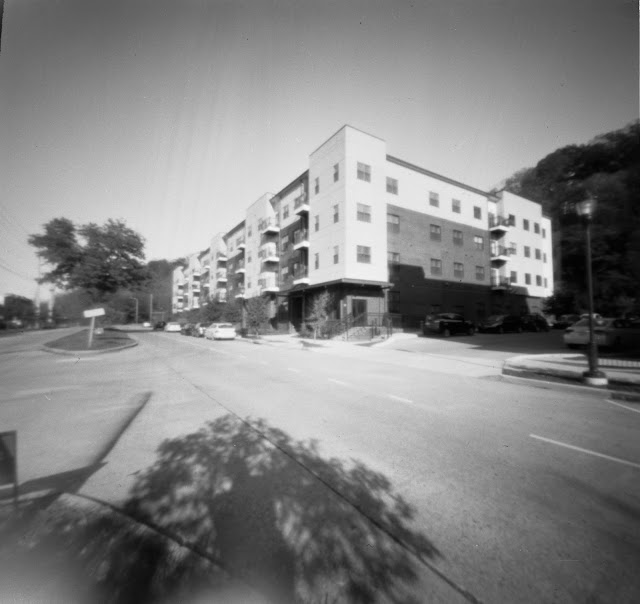In case you don’t know, a pinhole camera is a camera that lets light in through a very small hole instead of a lens. The idea of a pinhole camera reaches back to the very beginnings of photography. It likely was by accident that in ancient times someone discovered how light, when passing through a small hole in a wall, will project an upside down image on an opposite wall. Later, lenses were used to better focus the image, and the camera obscura was used a a drawing tool. Put light sensitive film instead of drawing paper in a camera obscura and . . . you have a film camera!
Pinhole cameras are interesting not only because they can be made out of a box or even a can, but also because the small size of the aperture (the pinhole) creates deep depths of field. Pinhole photographs can have an other-worldly look that can be quite attractive. However, this comes at a price: long exposure times. First, some way of keeping the pinhole camera rock-steady is essential, and this means a good tripod is essential. Second, calculating exposures can be very tricky. Simply taking the aperture size (f200, for example) and then using either Sunny f16 or a light meter to calculate the exposure time will not work with pinhole photography. Why not?
The answer lies with a certain film characteristic known as reciprocity failure. Reciprocity failure is a film's inability to respond to very low levels of light. While every film is different, most films require extra exposure over what your meter indicates. Fortunately, most films come with reciprocity failure information with instructions on how much exposure compensation the film needs. With color films, not only will they need exposure compensation, they also will need filtration to compensate for color shifts. And if that isn’t enough, development times have to be shortened to preserve the highlights.
This all sounds quite complicated, and I felt like a fish out of water as a loaded my newly bicultural PinBox camera with a roll of Kosmo Foto Mono 100 (a b&w film I quite like). So, thinking that “There's an app for that!,” I checked App Store for some help. Sure enough, I found lots of apps, but the one that seemed to be best is a paid app ($2.99) called Pinhole Assist. Not only does it serve as a light meter, but it had a built-in database of films and their reciprocity failure calculations. Once you have selected the film you are using, it will add the needed exposure compensation to the given time. It will even work with your smartphone's timer to tell you when to close the shutter.
With the Pinhole Assist app, my tripod, and the loaded PinBox camera in hand, I thought I was ready to go. However, I had one more problem to solve: how to mount the PinBox on my tripod. The little cardboard camera does not have a tripod mount. Channeling my inner MacGyver, I found my smartphone tripod attachment, mounted it on my tripod, and used it to clamp the PinBox onto the tripod. Yay! Now let’s go get some pinhole pitchas! I used the PinBox outside my condo building, at a nearby park with a large outdoor art sculpture, and at a well-known waterfall along the Cherohala Skyway.
While using the PinBox I soon noticed some difficulties. First, my DIY tripod mount was flimsy at best. Just pulling or pushing on the little cardboard shutter would move the camera, and when I saw the resulting photographs the effect of camera shake was evident in most of them. The PinBox will require a better tripod setup than what I currently have or can even imagine at the present. Furthermore, somewhere along the way I lost the 3-D printed take up side bottom winder key, and the result was that the film did not wind very tightly and some frames had overlap. Overall, it was a little frustrating using the camera while knowing that I was very possibly wasting time and film.
 |
| Ugh! Camera shake. |
One final problem which I will own is my choice of developer. Normally I like using Cinestill's Df96 Monobath with Kosmo Foto Mono 100 (which, of course, is actually Fomapan 100.) But I was not aware of the need to shorten the development time when making long exposures, and I couldn’t have done so anyway with Df96. As a monobath, it tells itself when to stop developing before the fixer takes over. So my negatives have some blown out highlights for sure.
 |
| Blown out highlights and frame overlap. |
Frankly, I was surprised to see anything on my negatives. But sure enough, I had images. Because I do not plan to make darkroom prints of any of these shots, I decided to go ahead and scan them. Most frames are forgettable, but with minimal exposure tweaking in Lightroom I was able to get some images which aren’t too bad.
 |
 |
The question now is: Will I use my PinBox again? At the present the answer depend on two things. 1. Perhaps Mr, Hamm will send me another bottom winder key, and 2. I have to make a way to eliminate camera movement. Film is too expensive to waste , and I have better medium format cameras that I don’t use enough. For now my Pinbox will remain a pinhole possibility.




